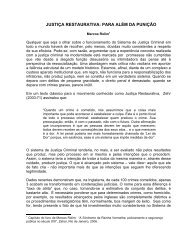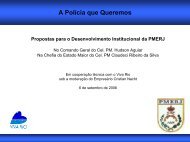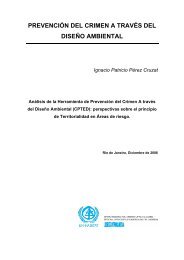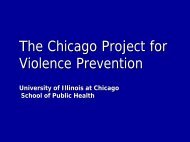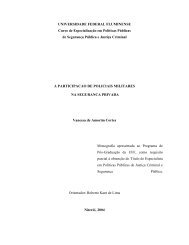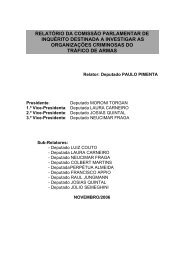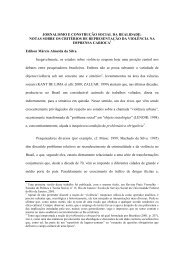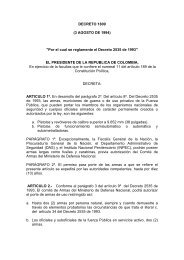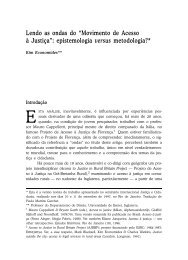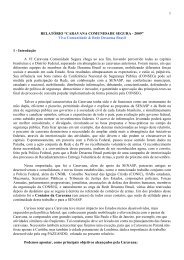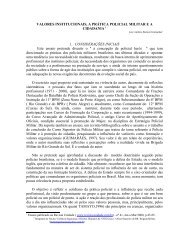The Coav Cities Project - Comunidade Segura
The Coav Cities Project - Comunidade Segura
The Coav Cities Project - Comunidade Segura
You also want an ePaper? Increase the reach of your titles
YUMPU automatically turns print PDFs into web optimized ePapers that Google loves.
COAV <strong>Cities</strong> <strong>Project</strong><br />
n International Comparisons<br />
• Niteroi, Rio de Janeiro (Brazil)<br />
• Medellin (Colombia)<br />
• Zacatecoluca (El Salvador)<br />
• Cape Town (South Africa)
Main Objectives (1/2)<br />
• To build on completed research and existing<br />
practical knowledge to treat the problem of<br />
COAV<br />
• To exchange knowledge on good practice for<br />
prevention and rehabilitation interventions<br />
from both situations of organised armed<br />
violence and post conflict
Main Objectives (2/2)<br />
• To develop local policy plans for prevention and<br />
the disarmament, demobilisation and reintegration<br />
of COAV, based on complete diagnosis of the<br />
problem and building on the integration of local<br />
government and civil society mechanisms<br />
• To advocate for the implementation of local policy<br />
plans through government and civil society<br />
partnership
Methodology (1/3)<br />
• Formation of a group composed by<br />
government and civil society key actors<br />
– Local government actors<br />
– NGO members<br />
– Academics<br />
– Church members<br />
– Police officers<br />
– Civil society representatives<br />
– Youth (separate meetings)
Methodology (2/3)<br />
• Elaboration of a rapid assessment of the situation of<br />
COAV in each locality<br />
• Identification of main thematic areas to be discussed<br />
during the meetings<br />
• Every group has chosen themes most relevant to<br />
the reality of their locality<br />
• Material to be used during the meetings:
Methodology (3/3)<br />
• <strong>The</strong>matic Papers<br />
• General and global vision of the problem<br />
• Local vision of the problem<br />
• Conclusions from Neither War nor Peace<br />
• Examples of good practices around the world<br />
• Outcomes included in a final report<br />
• available at www.coav.org.br<br />
• Proposals developed into policy papers by<br />
local partners
Common features found in all 4<br />
localities<br />
• Most affected population - Profile of aggressor<br />
and victims<br />
• Mostly composed by male (however a growing direct<br />
and indirect participation of women was found)<br />
• Afro descendents<br />
• 15 to 25 years old (the recruitment of new members of<br />
younger ages was detected)<br />
• Educational situation - drop outs from<br />
elementary school<br />
• Family situation - often, families headed by<br />
single woman<br />
• High unemployment rates<br />
• High social inequality
Common features<br />
• Little access to schooling<br />
• Low quality of education offered<br />
• Disbelief in positive future perspectives by<br />
COAV<br />
• Poverty – not as a main reason but as an<br />
existent risk factor<br />
• Ongoing exposure to gangs led children being<br />
familiar with elements of gang culture and<br />
activities – violence as a means of addressing<br />
conflict
Cross Cultural <strong>The</strong>mes (1/3)<br />
• Drug trafficking and drug consumption<br />
• Family involvement or participation in the<br />
rehabilitation process - little or none<br />
• Widespread presence of influences conducing<br />
to involvement in gangs in the environment<br />
where children live<br />
• Lack of alternatives / counter influences in<br />
the areas where gangs act
Cross Cultural <strong>The</strong>mes (2/3)<br />
n<br />
Arms<br />
– <strong>The</strong> symbolism of the gun<br />
• Feeling of inclusion, power, virility<br />
• Arms control & Youth at risk<br />
– Easy access to guns = increase of violence<br />
– Necessity of a stricter control of arms production<br />
and commerce, traffic and its use<br />
– Necessity of new legislation<br />
– Public security aimed at inhibiting the use of<br />
armed violence (rather than falling into it)
Cross Cultural <strong>The</strong>mes (3/3)<br />
• Education<br />
– Necessity of coordinated actions and policies between<br />
schools and other crucial institutions dealing with children<br />
and youth at risk<br />
– Include in the educational programme actions directed to<br />
the prevention of violence<br />
– Identify and provide individual attendance in coordination<br />
with other institutions to youth who are involved with<br />
gangs<br />
– Rethink the traditional school model<br />
– Design program, pedagogy and materials specifically aimed<br />
at youth at risk and drop outs (example: Tele Course<br />
Program by Viva Rio)
Common problems and<br />
recommendations identified in<br />
the COAV <strong>Cities</strong> <strong>Project</strong><br />
• Problems / Recommendations
Juvenile Justice System<br />
– Lack of alternative<br />
sentencing for<br />
children / youth<br />
–Placement of<br />
children and youth in<br />
institutions where<br />
gangs are present<br />
–Creation of<br />
alternative<br />
sentencing and<br />
diversion<br />
programmes<br />
– Avoid keeping<br />
children and youth in<br />
custody, mainly<br />
together with other<br />
gang members
Juvenile Justice System<br />
– Lack of adequate<br />
training for<br />
employees of<br />
correctional<br />
institutions<br />
– Lack of proper<br />
infrastructure in the<br />
correctional<br />
institutions<br />
– Need of specialized<br />
training for<br />
employees who deal<br />
with youth in<br />
custody<br />
– Improvement of the<br />
infrastructure of the<br />
correctional<br />
institutions
Family Participation<br />
– Little or no family<br />
participation in the<br />
process of rehabilitation<br />
and reintegration<br />
– Preparation of family<br />
members, encouraging<br />
them to take greater<br />
responsibility<br />
– Need to create<br />
reintegration<br />
programmes combining<br />
education, culture, work<br />
focusing also in the<br />
family as part of the<br />
process of reintegration<br />
– Families are often<br />
directly or indirectly part<br />
of the problem, thus,<br />
they need to be involved<br />
in the reintegration<br />
programme
Drugs<br />
• Children and youth as<br />
drug users<br />
• Drug addiction has to<br />
be seen and treated as<br />
a public health problem<br />
– Lack of institutions<br />
that can provide<br />
proper treatment to<br />
drug users<br />
–Design and<br />
implementation of<br />
preventive (at<br />
schools) and<br />
treatment<br />
programmes
Drugs<br />
• Family members as<br />
drug users or<br />
alcohol dependents<br />
–children are<br />
exposed daily to this<br />
reality<br />
• Early prevention -<br />
creation of<br />
programmes<br />
focusing on<br />
parenting and on<br />
the family as the<br />
unit that needs<br />
assistance
Other priorities identified by the<br />
working groups<br />
• Necessity to reduce the marginalization and<br />
stigmatization of the “young, black, poor”<br />
group<br />
• Improve the relation between police forces<br />
and poor communities<br />
• Let children and adolescents participate as<br />
the protagonists of their own story<br />
• Necessity to develop a workable conflict<br />
mediation strategy between gangs
Key steps in 2007 (1/2)<br />
• Public presentation of the proposals<br />
comprised in a Policy Paper to local<br />
authorities and civil society<br />
• Main objectives<br />
• Implement an advocacy strategy for the<br />
consolidation of COAV<br />
• Generate awareness and consolidate the<br />
theme in the municipality
Key steps in 2007 (2/2)<br />
– Introduce the theme / proposals in the<br />
public agenda<br />
– Consolidation of the proposal<br />
– Gather political support and definition of a<br />
concrete commitment by local authorities<br />
– Maintenance of the working groups and<br />
regular meetings in order to discuss<br />
further actions, difficulties, successes and<br />
new ideas
Let's work towards a new<br />
reality for COAV ?
Thank you!<br />
n 2nd, March 2007<br />
n clarissa@vivario.org.br




